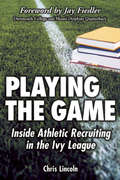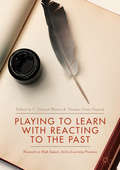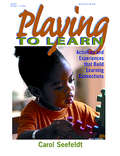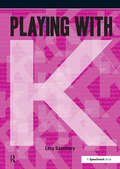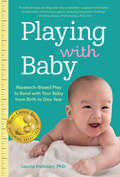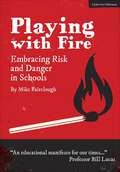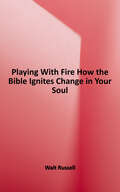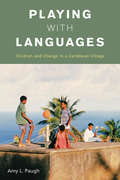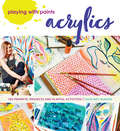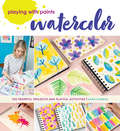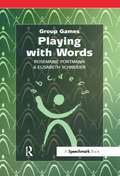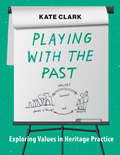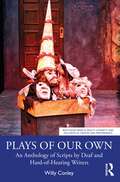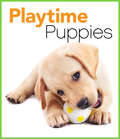- Table View
- List View
Playing the Game
by Jay Fiedler Chris LincolnPlaying The Game offers readers the first detailed, inside look at exactly how theathletic recruiting game is played by coaches, prospective students, parents,administrators, admission officers, and even college presidents in the Ivy Leagueand its Division III counterpart, the NESCAC. Here is the inside story on why thisspecialized process has caused so much controversy on campus and off.
Playing the PhD Game with Integrity: Connecting Research, Professional Practice and Educational Context (Understanding Teaching-Learning Practice)
by John A Bowden Pamela J GreenThis book focuses on integrity throughout the PhD journey and beyond, and is organised around two main themes: (1) integrity in relation to the capabilities developed by doctoral candidates for professional practice; and (2) integrity and coherence at the PhD system level. The working methods of key participants such as PhD candidates, supervisors, university managers, government agencies and politicians are central to achieving integrity goals within PhD programmes. In this context, a number of constructs are developed that inform the practice-based elements of the book in relation to conducting doctoral research, research supervision, academic writing, and research training support systems; in particular, these include our Moral Compass Framework for professional integrity, notions of collective morality, decision-making when faced with ‘wicked’ problems, connected moral capability and our double-helix model of capability development, negotiated sense in contrast with common sense, completion mindsets and contexts, mindfulness, liminality, and mutual catalysis in joint authorship.While the data the book employs stems from practice-led research within the Australian doctoral system, the conclusions drawn are of global relevance. Throughout the book, wherever appropriate, comparisons are made between the Australian context and other contexts, such as the doctoral systems of the United Kingdom, Europe and the United States.
Playing to Learn with Reacting to the Past
by C. Edward Watson Thomas Chase HagoodThis book provides classroom practice and research studies that verify Reacting to the Past (RTTP)--a student-centered, active learning pedagogy that provides college students and faculty unique teaching and learning opportunities--as a high impact practice for student learning and engagement. The overarching objective of this book is to collect practices and evidence from multiple disciplines and institution types regarding the efficacy of RTTP in higher education classroom settings. At its core, RTTP is a game-based pedagogy with published games on some of the most conflicted moments of human history. While RTTP is deeply grounded in theory and literature that suggests its approaches can be impactful, deep and broad examinations of RTTP pedagogies in a range of course settings have not been extensively performed until now. This book provides guidance and an evidence-base on which to build RTTP practices.
Playing to Learn: Activities and Experiences that Build Learning Connections
by Carol SeefeldtCreate meaningful experiences and engage children in learning through play. Playing to Learn gives you hundreds of activities to make learning fun through games, small group activities, stories, and more. These games and activities promote learning every day of the week, every week of the year. Sure to become a classroom favorite, Playing to Learn has everything you need to create wonderful learning experiences for young children.
Playing to Learn: The role of play in the early years
by Sandra SmidtSandra Smidt sets out to explain what play is and why it is so important as one of the key ways of learning, particularly - but not solely - for young children. She argues that all play is purposeful, and can only truly considered to be play when the child has chosen what to do, where and how to do it. Using case studies drawn from all over the world, Smidt challenges some of the prevailing myths relating to play and pays close attention to what it is that early years professionals need to do to interpet the play, understand its purpose for the child and sometimes extend it. Attention is paid to the close links that play has with creativity, and the author also highlights the importance of being able to explain to colleagues, parents and even those in government, why play matters so much in terms of learning and development. This book will be of interest to anyone involved in early years’ education.
Playing with ... K
by Lucy SanctuaryThis diverse and practical resource presents activities, games and ideas to support children who have speech sound difficulties between the age of 3 - 7 (older if used with children with a learning difficulty), eg developmental delay, disordered speech sounds, developmental apraxia of speech. The book is divided into seven main sections: mouth exercises (oro-motor exercises); single sounds (k); short words - consonant + vowel, eg, car, key, cow; longer words that begin with the speech sound k - consonant + vowel + consonant, eg, comb, can, cap; longer words that end with k, eg, book, bike, duck; words with more than one syllable that begin with k, eg, cooker, coffee, camel, caterpillar; and, using words in sentences. Each section provides the opportunity for the child to hear the speech sound in isolation and in words before they try to say it (ie receptive and expressive activities). Includes: different activities to practise listening and saying the target sound/word; drilling games - ie the opportunity to hear the speech sound in isolation and in words, and to say them in increasingly challenging sequences in a game format; games that can be played with the picture cards of the words the child is working on; and, an auditory bombardment section composed of funny rhymes containing the words, the child has been working on in the section. The resource contains simple, accessible information on the development of speech sounds and specific information about the speech sound k. Examples of session plans using the resource are included in the book to help users plan work.
Playing with ... P
by Lucy SanctuaryThis comprehensive resource presents activities, games and ideas to support the development of speech sounds in children aged 3-7 (or older if the child has learning difficulties). The book is divided into nine sections, including: Single sounds - p; short words - consonant + vowel, eg pea, pie; Longer words - consonant + vowel + consonant, eg peach, pin; even longer words - consonant + vowel + consonant + vowel, eg pepper, poppy, paper; and using phrases and words in sentences. Each section provides the opportunity for the child to hear the speech sound in isolation and in words before they try to say it (ie receptive and expressive activities). It includes: different activities to practise listening and saying the target sound/word; drilling games - ie the opportunity to hear the speech sound in isolation and in words and to say them in increasingly challenging sequences in a game format; games that can be played with the picture cards of the words the child is working on; and an auditory bombardment section composed of funny rhymes containing the words the child has been working on in the section. This flexible resource is interactive and aims to make speech sound work enjoyable, memorable and fun.
Playing with ... S
by Lucy SanctuaryPlaying with S is a resource book for Nursery Practitioners, Teachers, Teaching Assistants, Carers, Speech and language Therapists and Speech and Language Therapy Assistants to use in order to help children to say S in their talking. It contains activities, games and ideas to use with children aged from 3 - 7 years old. It can also be used with older children who have learning difficulties. Each section contains simple, easy-to-follow instructions and practical tips to help support the child. All the materials can be photocopies and instructions are given to help make resources for activities. There are progress sheets in each section to record progress in a fun way. Sample session plans are also included. The resource: Is divided into eleven sections which follow the acquisition of speech sounds in typically developing children; mouth (oro-motor exercises); single speech sound; short words that begin with the speech sound; longer words that begin with the speech sound s; words that end with the speech sound; words that begin or end with s and have more than one syllable; words that have the speech sound s in the middle of the word; opportunities to use all the words presented in the resource in phrases and sentences in a variety of activities and games; instructions and resources for games, which can be played with words from all the sections in the book to provide extra practise; ideas for working on saying s in words and sentences in the nursery, classroom and home; and session plans containing ideas for using this resource with children. There are ideas for making the activities more challenging in the sections and tips on how to make the activities easier, so you can tailor what you are doing to suit each individual child. Age 3-7 302 pp, A4, Wire-0-bound + downloadable resources.
Playing with Baby: Researched-Based Play to Bond with Your Baby from Birth to Year One
by Laurie HollmanBabies are amazing! From the moment they open their eyes, they are learning and developing at an astonishing rate. Parents naturally want to engage with infants as they learn and grow, but what if we could optimize the way we play with babies? Backed by the latest research and years of observation, Playing with Baby distills the experts&’ findings for new parents, giving them a guide to the first year of a baby&’s life and the growth of his or her individual mind. Through specific month-by-month play options and the research behind them, psychoanalyst Laurie Hollman helps us understand how to create secure attachments between baby and mother even before they can communicate with language. While aiding natural development is a big plus, the real payoff for parents comes from the baby&’s reaction: when we play on the baby&’s level, we engage and connect more deeply—and we have more fun!
Playing with Fire (A School for Spies Novel #1)
by Bruce HaleJuvenile delinquent and budding pyromaniac Max Segredo belongs in juvie hall. At least, that's what his most recent foster family would tell you. Instead, Max ends up on the doorstep of Merry Sunshine Orphanage-their very heavily guarded doorstep. As he begins to acclimate to his new home, Max learns a few things straightaway: first, cracking a Caesar Cipher isn't as hard as it seems; second, never sass your instructor if she's also holding throwing knives; and third, he may not be an orphan after all. Soon, Max and the rest of the students are sent on a mission to keep a dangerous weapon out of the hands of LOTUS, an international group bent on world domination. Of course, all Max cares about is finding out more about his father, the man he's now sure is still alive. As the stakes get higher, Max must make some difficult choices, including who to trust, and finally learns the true meaning of family.
Playing with Fire (Sweet Valley High #3)
by Francine Pascal Kate WilliamJessica Wakefield demands attention in any crowd, from every boy. After obsessing over him for weeks, she finally lands the perfect guy: Bruce Patman. And she falls hard and fast. There's nothing she won't do for him... But Elizabeth soon notices a change in her twin. Jessica's usual charm, determination, and attitude are gone. She's a ghost of her old self. And Liz wonders just how far her sister will go for love.
Playing with Fire: Embracing Risk and Danger in Schools
by Mike FaircloughThere is a misconception, within the teaching profession and the general public, that Ofsted, the Health and Safety Executive and the establishment are against children being exposed to danger and that schools are prevented from giving children experiences which involve risk. Mike Fairclough, headmaster at West Rise Junior School, has blown that theory out of the water. In the superb Playing With Fire, Mike urges all schools to follow his lead, empowering other Heads and their schools to provide activities for their pupils which include an element of risk and danger. With entertaining and visual examples of his work at West Rise, including bee keeping, water buffalo breeding, shooting, archery, Forest School, paddle boarding, and skinning rabbits, Mike breezily demonstrates how teething problems and mistakes are part and parcel of risk-taking and should be embraced. The result is an empowering book that urges educators to cultivate their own resilience, courage and trust in the same way that we are hoping to foster those qualities within our students.
Playing with Fire: Embracing Risk and Danger in Schools
by Mike FaircloughThere is a misconception, within the teaching profession and the general public, that Ofsted, the Health and Safety Executive and the establishment are against children being exposed to danger and that schools are prevented from giving children experiences which involve risk. Mike Fairclough, headmaster at West Rise Junior School, has blown that theory out of the water. In the superb Playing With Fire, Mike urges all schools to follow his lead, empowering other Heads and their schools to provide activities for their pupils which include an element of risk and danger. With entertaining and visual examples of his work at West Rise, including bee keeping, water buffalo breeding, shooting, archery, Forest School, paddle boarding, and skinning rabbits, Mike breezily demonstrates how teething problems and mistakes are part and parcel of risk-taking and should be embraced. The result is an empowering book that urges educators to cultivate their own resilience, courage and trust in the same way that we are hoping to foster those qualities within our students.
Playing with Fire: How the Bible Ignites Change in Your Soul
by Walt RussellBible scholar Walt Russell insists that studying the Scriptures properly is like playing with fire―a fire that can ignite dramatic change in our souls. With an intelligent, engaging style, Russell puts the tools in your hands that enable you to study different styles of biblical writing in depth. And this fuller understanding of God’s Word unleashes a heart-transforming power that burns away your defenses like fire, bringing radical change to your life.
Playing with Languages
by Amy L. PaughOver several generations villagers of Dominica have been shifting from Patwa, an Afro-French creole, to English, the official language. Despite government efforts at Patwa revitalization and cultural heritage tourism, rural caregivers and teachers prohibit children from speaking Patwa in their presence. Drawing on detailed ethnographic fieldwork and analysis of video-recorded social interaction in naturalistic home, school, village and urban settings, the study explores this paradox and examines the role of children and their social worlds. It offers much-needed insights into the study of language socialization, language shift and Caribbean children's agency and social lives, contributing to the burgeoning interdisciplinary study of children's cultures. Further, it demonstrates the critical role played by children in the transmission and transformation of linguistic practices, which ultimately may determine the fate of a language.
Playing with Paints - Acrylics: 100 Prompts, Projects And Playful Activities
by Courtney BurdenBreak the rules and explore acrylic paint in a free and fun way. This book encourages you to get over the fear of the blank canvas and the anxiety over the outcome so you can focus on the process of painting and the pure joy of creating. Whether you're a novice who doesn't know how to get started or a classical painter looking to try something new, you will benefit from the activities in this book, which range from quick, messy and expressive exercises to relaxing and meditative paintings. Courtney Pilgrim shares 100 prompts, projects and playful activities that will build your confidence, inspiring you to roll up your sleeves and play with acrylic paint in a pressure-free way. There is no right or wrong way to create a painting, so enjoy the journey, relax, unwind and have fun!
Playing with Paints - Watercolor: 100 Prompts, Projects And Playful Activities
by Sara FundukGet creative expressing yourself with watercolor paint by focusing on having fun and getting to know this versatile medium. More than 100 lessons help those who have never picked up a paintbrush before enjoy the pleasure of watercolor. In each chapter, you will progress through quick, simple exercises designed to get you started, then practice pages build on techniques. This book also shows those with more experience how to be inspired in new ways. Includes information on choosing supplies, mixing colors, making those first few brushstrokes, and quick, simple projects that range from making a joyful mess to beautiful pieces you can be proud of.
Playing with Scripture: Reading Contested Biblical Texts with Gadamer and Genre Theory (Routledge Interdisciplinary Perspectives on Biblical Criticism)
by Andrew JuddThis book puts a creative new reading of Hans-Georg Gadamer’s philosophical hermeneutics and literary genre theory to work on the problem of Scripture. Reading texts as Scripture brings two hermeneutical assumptions into tension: that the text will continually say something new and relevant to the present situation, and that the text has stability and authority over readers. Given how contested the Bible’s meaning is, how is it possible to ‘read Scripture’ as authoritative and relevant? Rather than anchor meaning in author, text or reader, Gadamer’s phenomenological model of hermeneutical experience as Spiel (‘play’) offers a dynamic, intersubjective account of how understanding happens, avoiding the dead end of the subjective–objective dichotomy. Modern genre theory addresses some of the criticisms of Gadamer, accounting for the different roles played by readers in different genres using the new term Lesespiel (‘reading game’). This is tested in three case studies of contested texts: the recontextualization of psalms in the book of Acts, the use of Hagar’s story (Genesis 16) in nineteenth-century debates over slavery and the troubling reception history of the rape and murder in Gibeah (Judges 19). In each study, the application of ancient text to contemporary situation is neither arbitrary, nor slavishly bound to tradition, but playful.
Playing with Scripture: Reading Contested Biblical Texts with Gadamer and Genre Theory (Routledge Interdisciplinary Perspectives on Biblical Criticism)
by Andrew JuddThis book puts a creative new reading of Hans-Georg Gadamer’s philosophical hermeneutics and literary genre theory to work on the problem of Scripture. Reading texts as Scripture brings two hermeneutical assumptions into tension: that the text will continually say something new and relevant to the present situation, and that the text has stability and authority over readers. Given how contested the Bible’s meaning is, how is it possible to ‘read Scripture’ as authoritative and relevant? Rather than anchor meaning in author, text or reader, Gadamer’s phenomenological model of hermeneutical experience as Spiel (‘play’) offers a dynamic, intersubjective account of how understanding happens, avoiding the dead end of the subjective–objective dichotomy. Modern genre theory addresses some of the criticisms of Gadamer, accounting for the different roles played by readers in different genres using the new term Lesespiel (‘reading game’). This is tested in three case studies of contested texts: the recontextualization of psalms in the book of Acts, the use of Hagar’s story (Genesis 16) in nineteenth-century debates over slavery and the troubling reception history of the rape and murder in Gibeah (Judges 19). In each study, the application of ancient text to contemporary situation is neither arbitrary, nor slavishly bound to tradition, but playful.
Playing with Words (Group Games Ser.)
by Rosemary Portmann Elisabeth SchneiderWith an emphasis on learning through play, this book provides a comprehensive collection of word games for vocabulary development or to constructively fill leisure time. The activities are suitable for children and adults and can be adapted for different client groups. They are ideal for teachers, therapists, youth club leaders or activity providers. The only principle for including a game in this collection is that it had to be fun to play! This title includes: A-E-I-O-U; Letter patience; 'M' in the middle; double meanings; Pro-nouns; Haiku; Guessing rhyming words; Forbidden letters; Who has the word?; and Word snakes. The only principle for including a game in this collection is that it had to be fun to play!
Playing with the Past: Exploring Values in Heritage Practice
by Kate ClarkHeritage is all around us, not just in monuments and museums, but in places that matter, in the countryside and in collections and stories. It touches all of us. How do we decide what to preserve? How do we make the case for heritage when there are so many other priorities? Playing with the Past is the first ever action-learning book about heritage. Over eighty creative activities and games encompass the basics of heritage practice, from management and decisionmaking to community engagement and leadership. Although designed to ‘train the trainers’, the activities in the book are relevant to anyone involved in caring for heritage.
Plays of Our Own: An Anthology of Scripts by Deaf and Hard-of-Hearing Writers (Routledge Series in Equity, Diversity, and Inclusion in Theatre and Performance)
by Willy ConleyPlays of Our Own is the first anthology of its kind containing an eclectic range of plays by Deaf and hard-of-hearing writers. These writers have made major, positive contributions to world drama or Deaf theatre arts. Their topics range from those completely unrelated to deafness to those with strong Deaf-related themes such as a dreamy, headstrong girl surviving a male-dominated world in Depression-era Ireland; a famous Spanish artist losing his hearing while creating his most controversial art; a Deaf African-American woman dealing with AIDS in her family; and a Deaf peddler ridiculed and rejected by his own kind for selling ABC fingerspelling cards. The plays are varied in style – a Kabuki western, an ensemble-created variety show, a visual-gestural play with no spoken nor signed language, a cartoon tragicomedy, historical and domestic dramas, and a situation comedy. This volume contains the well-known Deaf theatre classics, My Third Eye and A Play of Our Own. At long last, directors, producers, Deaf and hearing students, professors, and researchers will be able to pick up a book of "Deaf plays" for production consideration, Deaf culture or multicultural analysis, or the simple pleasure of reading.
Playtime Kittens
by Leah Tracosas Beth JohnstonKittens love to have fun! Playtime Kittens pairs an easy-to-read rhyme with adorable photos of kittens at play. Have fun, Playtime Kittens!
Playtime Puppies
by Katie McconnaugheyPuppies love to have fun! Playtime Puppies pairs an easy-to-read rhyme with adorable photos of puppies at play. Have fun, Playtime Puppies!
Playwork Practice at the Margins: Research Perspectives from Diverse Settings (Advances in Playwork Research)
by Jennifer Cartmel; Rick WorchPlaywork Practice at the Margins explores the circumstances where playwork practice intersects with practice from diverse contexts and settings, encompassing disciplines such as health, education, early intervention and community development. Each chapter focuses on a research project situated in a unique setting or space such as zoos, hospitals, refuges and rainforests. In these settings, the authors reflect on Playwork Principles and consider these in relation to the theory, research, design and findings of their project. By presenting research from settings at the margins of traditional playwork, the authors use shared values and principles to consider the significance of playwork when embedded in transdisciplinary work. The book is underpinned by a model of reflective thinking that is used to examine how playwork practice is intertwined with knowledge from other disciplines. With a range of international contributions from both researchers and practitioners, this is the ideal text for academics and researchers in the fields of early childhood education, allied health, community development and social work disciplines as well as human geographers and practitioners in children’s services worldwide.
